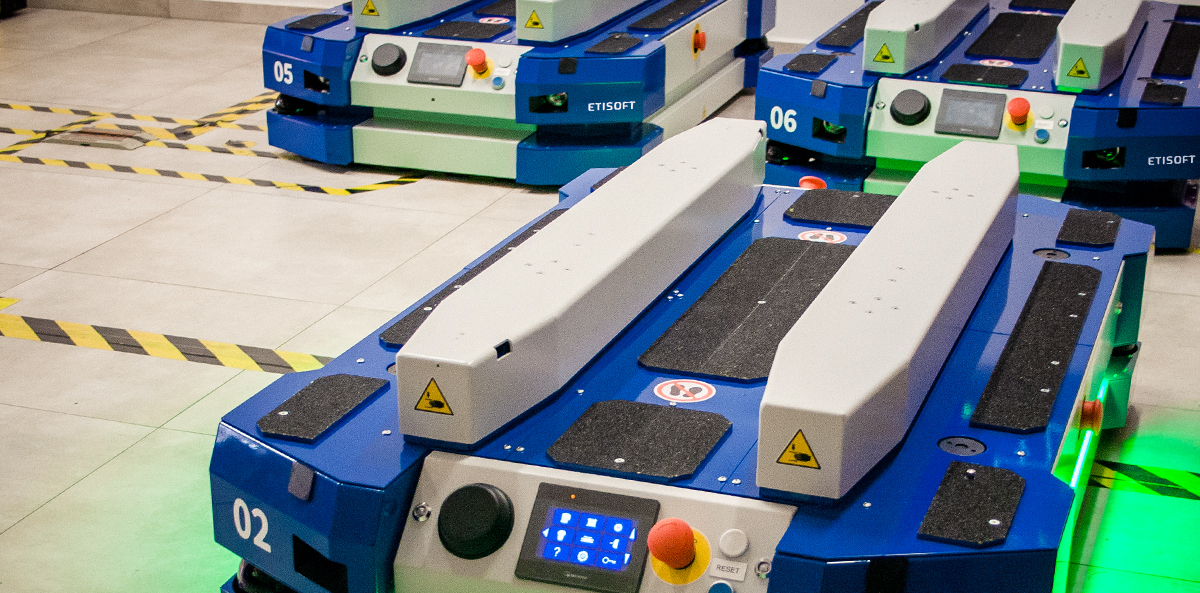
AGVs or AMRs, or what level of autonomy to apply?
Automation of intralogistics processes is becoming increasingly popular. Producers compete in promoting advantages of their autonomous robots and vehicles such as AGVs (Automated Guided Vehicles) and AMRs (Autonomous Mobile Robots), emphasising above all the virtues of the latter. Many people wonder how the two types of transport actually differ. At first glance, the most obvious differences are in the navigation manner. Indeed, AGVs move along magnetic or optical tapes. Such vehicles are often referred to as line followers. AMRs, on the other hand, use more sophisticated means of navigation, for example, using SLAM technology (Simultaneous Localization and Mapping). But is it the most important difference? And do AMRs even have to move tapeless?
We answer these questions comparing, at the same time, AGVs and AMRs.
Automated or traditional warehouse – which to choose? Check it!
Equipment
At first glance, AGVs and AMRs look similar. They have almost identical mechanical design, drive system and safety solutions. The only difference, which often goes unnoticed, is the number of additional sensors, such as 3D cameras and high-performance control computers. So, if in terms of hardware, both vehicles are constructed in a similar way, where are these fundamental differences?
Autonomy level decides
AMRs are highly autonomous robots. It allows them to operate in a changing industrial environment, e.g., by avoiding obstacles by dynamically setting a new travel path. AGVs, on the other hand, are not fully autonomous and perform pre-planned logistical tasks along pre-determined navigation paths. Is it a disadvantage of AGV-based intralogistics systems? Not necessarily. It all depends on the operating environment of the intralogistics system. Due to the fact that the autonomy limit at which an AGV ceases to be an AGV and becomes an AMR has not been clearly established, analogies can be searched for in the world of similar technologies.

For example, to the scale developed in the USA in 2014 by SAE (International Society of Automotive Engineers) for consumer vehicles such as cars. In this model, the level of autonomy is defined from 0 – 5, where 0 is full driver’s control of the vehicle, and 5 is a vehicle where driver intervention is not required. Transferring these assumptions to the world of intralogistics automation, it is possible to say that 0 would be an operator-operated forklift truck, 1,2,3 would be AGVs, and 4 and 5 would be AMRs. However, it should be noted that whether you drive a car that is more or less equipped with advanced driver assistance systems, the objective is to reach your destination. This will not always be achieved more quickly with a fully autonomous vehicle. Therefore, AGVs/AMRs may differ in their autonomy level. So, what makes a mode of transport more or less autonomous?
Programmed intelligence
Since we have established that in terms of hardware, AGVs and AMRs are almost identical, autonomy is determined by advanced control algorithms implemented in the computers controlling the robots. These are most frequently used for such functions as:
- obstacle avoidance
- navigation path mapping
- identification of logistical carriers
- advanced energy balance management
- predictive maintenance
- adjustment of speed to the prevailing conditions.
Therefore, it is the quality of the software that is crucial to whether an autonomous vehicle is still an AGV or already an AMR. The type of navigation to be used by the robot is just one of many parameters that an intralogistics system architect takes into consideration when preparing a custom-made solution. Of course, the use of SLAM-type technology provides an opportunity to increase the level of autonomy of the vehicle. However, it is not the only and frequently not the most significant element determining whether a vehicle is still an AGV or already an AMR.
AGV/AMR is just a tool
From the perspective of the intralogistics system architect, what matters most is, above all, the objectives, and tasks to be achieved by the system in accordance with the process requirements, such as system performance. The point is that the system should have exactly those functions, implemented by means of hardware and software, which are necessary in the factory for optimal operation of the production process. Of course, this takes into consideration the physical constraints resulting from the infrastructure, the process constraints resulting from the production technology and the financial constraints which frequently determine the decision to invest in automation.
It may sometimes turn out that many functions typical of AMRs are unnecessary for a particular process and an AGV-based system is sufficient. This also affects the all-important implementation costs. As a rule, the more complex the software, the higher the price of the system. It is interesting to note that in one of its implementations Etisoft Smart Solutions used AMRs using magnetic tape navigation. So, it is not said that this type of robots must use only SLAM navigation. What is more, in some factories there are even some counter-indications to using AMRs with this type of movement. The reason for this could be heavy dustiness in the plant that prevents sensors (e.g., lidars or 3D cameras) from operating properly, or the poor quality of the Wi-Fi network infrastructure used by the robot to transmit telemetry data. There are also reverse situations, for example, a system based on simpler AGVs is enough to operate the process, but the conditions in the factory (e.g., other heavy vehicles that can destroy the magnetic tape) make it necessary to equip it with SLAM-type technology or another navigation type.
The best place to begin is by consulting the experts
Designing an intralogistics system is a challenging undertaking which requires design and implementation competences. It is worth starting with a conversation with experts who have completed projects in production companies and are able to design a custom-made system. They will advise you which software the robot should be equipped with depending on the objective to be achieved. So, whether it is an AGV, or an AMR is a secondary issue, although we can expect than the future will rather be dominated by vehicles with greater level of autonomy.
Would you like to talk about an intralogistics system based on mobile robots? You are welcome to contact us!
